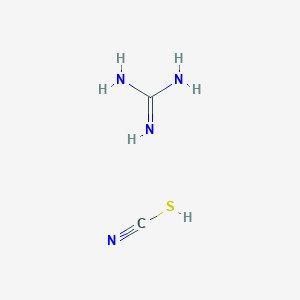



1. Guanidinium Thiocyanate
2. Guscn
1. 593-84-0
2. Guanidinium Thiocyanate
3. Guanidinium Rhodanide
4. Guanidine;thiocyanic Acid
5. Guanidinium Isothiocyanate
6. Thiocyanic Acid, Compd. With Guanidine (1:1)
7. Mfcd00013027
8. Gca2eu297u
9. Nsc-2119
10. Gtc
11. Usaf Ek-705
12. Guanidinethiocyanate
13. Nsc 2119
14. Einecs 209-812-1
15. Buffer Avl
16. Ai3-18430
17. Unii-gca2eu297u
18. Schembl28942
19. Guanidine Thiocyanate Solu-tion
20. Guanidine Thiocyanate, Ultrapure
21. Dtxsid6060478
22. Isothiocyanic Acid, Compd. With Guanidine (1:1) (van)
23. Nsc2119
24. Guanidine Thiocyanate, >=99.5%
25. Hy-d0841
26. Akos015961014
27. Guanidine Thiocyanate, >=97.0% (at)
28. Bp-13066
29. Ls-12942
30. Sy003172
31. Guanidine Thiocyanate, >=97% (titration)
32. Cs-0014812
33. G0230
34. G0360
35. Guanidine Thiocyanate, Molecular Biology Grade
36. G-8100
37. G-8102
38. M01833
39. Isothiocyanic Acid, Compd. With Guanidine (1:1)
40. Q904487
41. Guanidine Thiocyanate, For Molecular Biology, >=99%
42. Guanidine Thiocyanate, Vetec(tm) Reagent Grade, >=97%
43. Guanidine Thiocyanate, Bioreagent, For Molecular Biology, >=99%
44. Guanidine Thiocyanate, Bioultra, For Molecular Biology, >=99.0% (at)
45. Guanidine Thiocyanate Solution, Bioultra, For Molecular Biology, ~4 M In H2o
46. Guanidine Thiocyanate Solution, Bioultra, For Molecular Biology, ~6 M In H2o
| Molecular Weight | 118.16 g/mol |
|---|---|
| Molecular Formula | C2H6N4S |
| Hydrogen Bond Donor Count | 4 |
| Hydrogen Bond Acceptor Count | 3 |
| Rotatable Bond Count | 0 |
| Exact Mass | 118.03131738 g/mol |
| Monoisotopic Mass | 118.03131738 g/mol |
| Topological Polar Surface Area | 101 Ų |
| Heavy Atom Count | 7 |
| Formal Charge | 0 |
| Complexity | 57.6 |
| Isotope Atom Count | 0 |
| Defined Atom Stereocenter Count | 0 |
| Undefined Atom Stereocenter Count | 0 |
| Defined Bond Stereocenter Count | 0 |
| Undefined Bond Stereocenter Count | 0 |
| Covalently Bonded Unit Count | 2 |
Disinfectants
Substances used on inanimate objects that destroy harmful microorganisms or inhibit their activity. Disinfectants are classed as complete, destroying SPORES as well as vegetative forms of microorganisms, or incomplete, destroying only vegetative forms of the organisms. They are distinguished from ANTISEPTICS, which are local anti-infective agents used on humans and other animals. (From Hawley's Condensed Chemical Dictionary, 11th ed) (See all compounds classified as Disinfectants.)